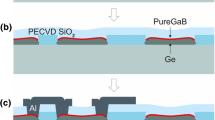Abstract
Conventionally, lifetests of semiconductor laser diodes usually involved operating the devices continuously at either constant power output or drive current, with periodic recording of their characteristics. In this paper, some effects arising from interrupted lifetest of 1.3 μm GaInAsP-InP inverted-rib laser diodes are reported. This unconventional lifetest method involves constant power biasing at 4 mW/facet and 8 mW/facet respectively at 50°C, followed by a period during which the lifetest is interrupted and the devices left unbiased at room temperature. Subsequently, the devices were put back on constant power biasing at 50°C. Among a number of parameters, pronounced reduction in the threshold current, current for 4 mW/facet and 8 mW/facet were observed, indicating strong recovery effects commencing from the time when the life-test was interrupted. Redistribution of mobile defects in the cladding layer is postulated to be the cause of the degradation recovery, and the data supports the occurrence of an aging-current dependent defect annihilation mechanism. Such recovery effects have so far been observed to occur only in the GaInAsP-InP inverted-rib devices.
Similar content being viewed by others
References
T.Y. Li, “Advances in optical fiber communications: An historical perspective,”IEEE J. Select. Areas Commun., vol. SAC-1, pp. 356–372, April 1983.
R.C. Hooper, J.E. Midwinter, D.W. Smith, and I.W. Stanley, “Progress in monomode transmission techniques in the United Kingdom,”J. Lightwave Technol., vol. LT-1, pp. 596–609, Dec. 1983.
F.R. Nash, W.B. Joyce, R.L. Hartman, E.I. Gordon, and R.W. Dixon, “Selection of a laser reliability assurance strategy for a long-life application,”AT&T Tech. J., vol. 64, pp. 671–715, March 1985.
H. Yonezu, S. Katayama, N. Fujine, I. Sakuma, and K. Nishida, “Reliability of light emitters and detectors for optical fiber communication systems,”IEEE J. Select. Areas Commun., vol. SAC-1, pp. 508–514, April 1983.
H. Imai et al., “Accelerated aging test of InGaAsP/InP double heterostructure laser diodes with single transverse mode,”Appl. Phys. Lett., vol. 38, pp. 16–17, Jan. 1981.
S.E.H. Turley et al., “Properties of inverted rib waveguide lasers operating at 1.3 μm wavelength,”Electron. Lett., vol. 17, pp. 868–870, Nov. 1981.
S.E.H. Turley et al., “Optical waveguiding in (In,Ga) (As,P) inverted rib waveguide lasers at 1.3 μm wavelength,”IEEE J. Quantum Electron, vol. QE-19, pp. 1186–1195, July 1983.
S.F. Yoon, “The annealing of double-heterostructure GaInAsP-InP 1.3 μm laser diodes,”IEEE J. Quantum Electron., vol. QE-27, pp. 30–39, Jan. 1991.
S.F. Yoon, “Observation of nonbiased degradation recovery in GaInAsP/InP laser diodes,”IEEE/OSA J. Lightwave Tech., vol. LT-10, pp. 194–198, Jan. 1992.
Y. Horikoshi, T. Kobayashi, and Y. Furukawa, “Lifetime of InGaAsP-InP and AlGaAs-GaAs DH lasers estimated by the point defect generation model,”Japanese J. Appl. Phys., vol. 18, pp. 2237–2244, Dec. 1979.
B. Thomas, A. Kar, G.D. Henshall, and K. Jones, “Forward bias voltage characteristics for (GaAl)As and (GaIn)(AsP) lasers,”IEE Proc., vol. 129, pp. 312–315, Dec. 1982.
P.A. Kirkby, A.R. Goodwin, G.H.B. Thomson, and P.R. Selway, “Observations of self-focusing in stripe geometry semiconductor lasers and the development of a comprehensive model of their operation,”IEEE J. Quantum Electron., vol. QE-13, pp. 705–719, Aug. 1977.
F. Nash et al., “Implementation of the proposed reliability assurance for an InGaAsP/InP, planar mesa buried heterostructure laser operating at 1.3 μm for use in submarine cable,”AT&T Tech. J., vol. 64, pp. 809–860, March. 1985.
Author information
Authors and Affiliations
Rights and permissions
About this article
Cite this article
Yoon, S.F. Some observations from interrupted lifetest of GaInAsP/InP inverted-rib laser diodes. J Electron Test 6, 117–125 (1995). https://doi.org/10.1007/BF00993134
Received:
Revised:
Issue Date:
DOI: https://doi.org/10.1007/BF00993134




